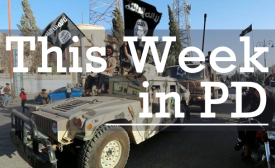propaganda
The government has ordered TV stations to increase the airing of “patriotic” shows, of which anti-Japan dramas are exhibit No. 1. On Aug. 15, the anniversary of Japan’s surrender, a headline in the Global Times, a party newspaper, said, “Prime time TV to be more anti-fascist.” China has a long tradition of producing war movies for propaganda purposes, mostly good-versus-evil dramas drawn from the all-too-real and brutal war against Japan.
The video that became prominent last week is one of several on a new State Department YouTube channel in English aimed at disaffected young Western Muslims who may be wowed by the Islamic State’s battlefield momentum. The counter message is simple: These guys are lying to you, and if you go to Syria to fight Western oppression you’ll just end up killing innocent Muslims.
If it wants to strengthen its presence in the international community and adequately inform a wider audience abroad about itself, Japan should strategically strengthen its public relations overseas and promote cultural exchanges with other nations. In its budgetary request for fiscal 2015, the Foreign Ministry has requested about 50 billion yen (about $475 million) for a new key budgetary item called "strategic proliferation of information abroad."
While many around the web have questioned how just how "factual" some of the publisher's representations are, most can agree that its colouring books are in fact unique — albeit incredibly controversial. The updated books are said to feature such topics as the release of Taliban prisoners for the freedom of Sgt. Bowe Bergdahl, the Boston Marathon bombing, and, as Bell puts it, "these brutal people, these terrible humans on the planet called ISIS.”
The extremists who have seized large parts ofSyria and Iraq have riveted the world’s attention with their military prowess and unrestrained brutality. But Western intelligence services are also worried about their extraordinary command of seemingly less lethal weapons: state-of-the-art videos, ground images shot from drones and multilingual Twitter messages.
With its image battered by the conflict in Ukraine, Russia is accelerating its push to rebuild, modernize and expand its Soviet-era foreign media apparatus. One country of focus is Germany, the European economic powerhouse that has both close ties to Russia and rising public resentment of the U.S.

This week in PD, the world witnessed the propaganda of violent extremist groups, including the Islamic State.
The Islamic State’s “A Message to America,” showing American journalist James Foley’s final moments, is vile and horrifying. Significantly, unlike the early propaganda of Al Qaeda, this video is also professionally cut and edited. It is the sort of thing engineered to achieve rapid, viral spread on the open internet. It also represents the main weapon the Islamic State is increasingly employing to great effect against the West.







